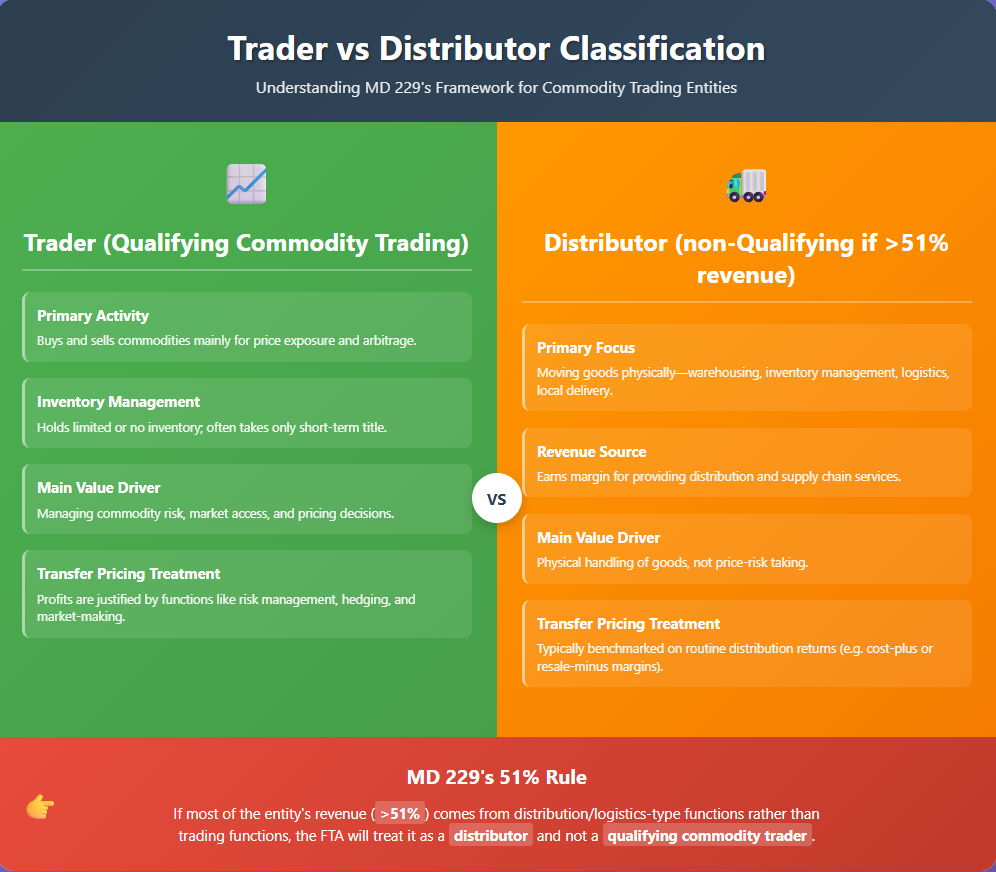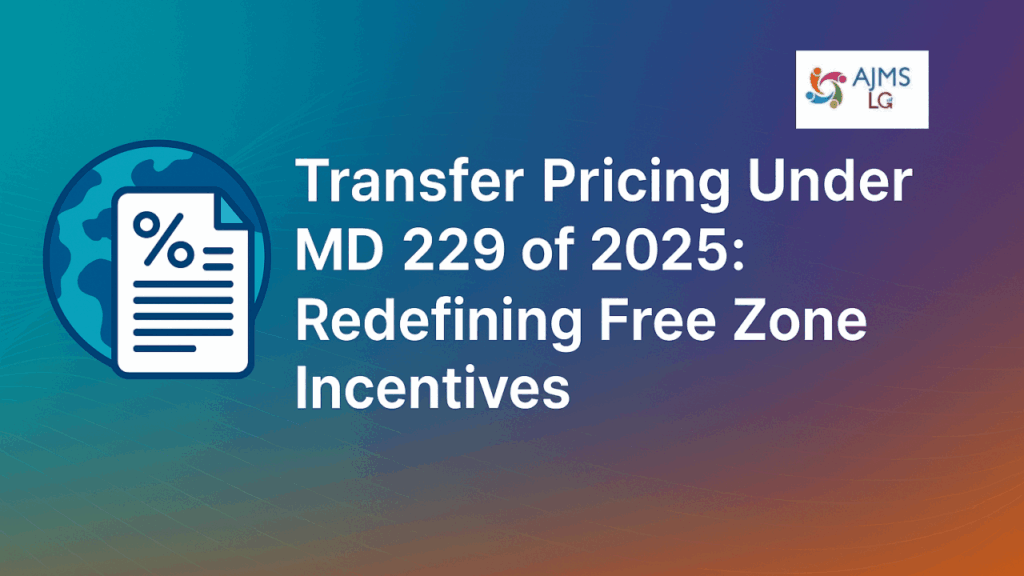Table of Contents
ToggleA New Phase for Free Zone Incentives
The UAE has replaced Ministerial Decision 265 of 2023 with MD 229 of 2025 on Qualifying and Excluded Activities, and issued MD 230 of 2025 naming the Recognised Price Reporting Agencies (PRAs). On paper, these changes look like refinements in definitions. But for Free Zone businesses engaged in related party transactions, the impact is far more profound. Under the Corporate Tax Law, the 0% Free Zone regime is only available if the entity complies with the arm’s length principle in dealings with Related Parties. This means every expansion or restriction in the list of Qualifying Activities must now be interpreted through a transfer pricing lens whenever intra-group transactions are involved.
Trading of Qualifying Commodities – Beyond “Raw Form”
Under the old rules, only raw commodities like crude oil or unrefined metals were covered. MD 229 removes this restriction. Now, industrial chemicals, agricultural goods, energy products, by-products, and even carbon credits or renewable energy certificates can qualify, provided there is a Quoted Price from a recognised exchange or PRA.
For related party trading transactions, this is a major change. Intra-group sales or purchases must now be priced with reference to these external benchmarks. Independent commodity traders use PRAs such as Platts or Argus; Free Zone entities must do the same when transacting with group companies. The TP file should explain not only which PRA price was chosen but also how adjustments were made for quality, timing, or delivery terms. Without this, the tax authority could argue that the related party price is not arm’s length, which risks reclassifying the income as non-qualifying.
The 51% Guardrail – Distinguishing Trader from Distributor
MD 229 introduces a functional restriction: a Free Zone entity will not be treated as conducting Qualifying Commodity Trading if 51% or more of its revenue comes from distribution, warehousing, or logistics.
For transfer pricing, this makes functional analysis in related party contexts critical. A trader earns its return by taking market and price risk; a distributor earns a margin for logistics and inventory management. Where the Free Zone entity trades mainly with related parties, the TP documentation must clearly demonstrate trader functions who takes title, who manages commodity price risk, and who makes trading decisions. If the entity looks more like a distributor for its group, the tax authority could deny Qualifying status even if the intercompany prices themselves are benchmarked.

Structured Commodity Finance – Linking Finance Back to Related Party Trade
MD 229 now recognize structured commodity finance such as prepayment, forfaiting, receivable financing, and streaming finance as part of Qualifying Commodity Trading, provided it is linked to the physical trade.
This is directly relevant to related party arrangements. Many groups run intra-group financing to support commodity flows. Under the old regime, such financing might have been treated as an excluded activity, exposing the entity to 9% tax. Now it can qualify, but only if the financing is clearly ancillary to the trade. TP documentation must demonstrate that the terms mirror what an independent trader would accept, and that the pricing reflects both credit and commodity risk. If the financing is structured like a stand-alone loan within the group, without a genuine link to the trade, it could still be treated as an excluded activity.
Treasury and Financing Services – Own Account vs Related Party
MD 229 also expands treasury activities to cover financing “for own account.” This clarification means that interest from deposits or treasury investments can qualify if all other conditions are met. However, this part is mainly relevant where there are no related party dealings.
Where treasury and financing services are provided to related parties, the TP angle remains decisive. A Free Zone entity acting as the group treasury hub must prove that the functions performed in the Free Zone justify the margin it earns on intercompany loans or cash pooling. Simply booking interest income without demonstrating decision-making substance will not survive audit. The TP file should show how pricing was set, which benchmarks were used, and why the return reflects risks managed within the Free Zone.
Distribution Activities – Extension to Public Benefit Entities
MD 229 confirms that distribution of goods in or from a Designated Zone is Qualifying. The new element is that supplies to Public Benefit Entities (PBEs) now qualify, even if those goods are not resold or processed.
In related party contexts, this creates comparability challenges. If a Free Zone entity supplies a group-affiliated PBE at concessional or below-market rates, TP documentation must explain why this pricing reflects independent behaviour. Independent enterprises sometimes supply PBEs on favourable terms for reputational or policy reasons. Capturing this rationale in the TP file is essential; otherwise, concessional related party pricing could be reclassified as non-arm’s length and treated as non-qualifying income.
Excluded Activities – Carve-Out for Trade-Linked Finance
Previously, financing and leasing were generally excluded activities. MD 229 narrows this by carving out financing that is directly tied to commodity trading.
For related party transactions, this puts the burden squarely on TP documentation. If a Free Zone entity provides financing to its affiliates, it must demonstrate that the financing is integral to group commodity trades and is priced as such. If the financing stands alone, with no genuine link to trade, it risks being reclassified as excluded, potentially stripping the entity of its QFZP status.
Recognised PRAs – Evidence for Related Party Pricing
MD 230 of 2025 lists 13 Recognised PRAs, including Platts, Argus, Fastmarkets, ICIS, and ICE. This formalises the benchmarks that must underpin commodity pricing. For related party commodity trades, this closes the debate about which benchmarks can be used. The TP file must now focus on the integrity of adjustments, how PRA prices are aligned to the actual transaction terms. For the tax authority, the question may not be “what benchmark?” but “what adjustment and why?”.
Conclusion – Transfer Pricing as the Gatekeeper of Incentives
MD 229 and MD 230 lock transfer pricing into the very heart of the Free Zone regime but only where related party transactions exist. In these cases, commodity trades must be benchmarked to PRA prices, structured finance must be proven as trade-linked, treasury margins must be supported by local substance, and supplies to PBEs must be justified as arm’s length.
For taxpayers, the 0% rate is no longer an entitlement; it is a reward earned each year through defensible TP documentation that shows the Free Zone entity behaves like an independent enterprise in its group dealings. For advisors, the challenge is to move beyond generic benchmarking into integrated narratives that connect functions, risks, and financial outcomes.
The Free Zone promise remains. But its survival now depends on the discipline of transfer pricing. Those who embed TP into every related party dealing will preserve the 0% regime. Those who treat it as an afterthought risk turning Free Zone privilege into a 9% liability.

